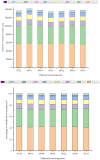Based on HPLC and HS-GC-IMS Techniques, the Changes in the Internal Chemical Components of Schisandra chinensis (Turcz.) Baill. Fruit at Different Harvesting Periods Were Analyzed
- PMID: 38675712
- PMCID: PMC11055173
- DOI: 10.3390/molecules29081893
Based on HPLC and HS-GC-IMS Techniques, the Changes in the Internal Chemical Components of Schisandra chinensis (Turcz.) Baill. Fruit at Different Harvesting Periods Were Analyzed
Abstract
Schisandra chinensis, as a traditional Chinese herbal medicine, has clear pharmacological effects such as treating asthma, protecting nerves and blood vessels, and having anti-inflammatory properties. Although the Schisandra chinensis fruit contain multiple active components, the lignans have been widely studied as the primary pharmacologically active compound. The volatile chemical components of Schisandra chinensis include a large amount of terpenes, which have been proven to have broad pharmacological activities. However, when to harvest to ensure the highest accumulation of pharmacologically active components in Schisandra chinensis fruits is a critical issue. The Schisandra chinensis fruit trees in the resource nursery were all planted in 2019 and began bearing fruit in 2021. Their nutritional status and tree vigor remain consistently good. The content of lignans and organic acids in the fruits of Schisandra chinensis over seven different harvest periods was tested, and the results of high-performance liquid chromatography (HPLC) indicated that the lignan content was higher, at 35 mg/g, in late July, and the organic acid content was higher, at 72.34 mg/g, in early September. If lignans and organic acids are to be selected as raw materials for pharmacological development, the harvest can be carried out at this stage. Using HS-GC-IMS technology, a total of 67 volatile flavor substances were detected, and the fingerprint of the volatile flavor substances in the different picking periods was established. It was shown by the results that the content of volatile flavor substances was the highest in early August, and 16 flavor substances were selected by odor activity value (OAV). The variable importance in projection (VIP) values of 16 substances were further screened, and terpinolene was identified as the key volatile flavor substance that caused the aroma characteristics of Schisandra chinensis fruit at different harvesting periods. If the aroma component content of Schisandra chinensis fruit is planned to be used as raw material for development and utilization, then early August, when the aroma component content is higher, should be chosen as the time for harvest. This study provides a theoretical basis for the suitable harvesting time of Schisandra chinensis for different uses, and promotes the high-quality development of the Schisandra chinensis industry.
Keywords: Schisandra chinensis; harvest time; lignans; organic acids; volatile compounds.
Conflict of interest statement
The authors declare no conflict of interest.
Figures









Similar articles
-
Analysis of Volatile Components in Dried Fruits and Branch Exudates of Schisandra chinensis with Different Fruit Colors Using GC-IMS Technology.Molecules. 2023 Sep 29;28(19):6865. doi: 10.3390/molecules28196865. Molecules. 2023. PMID: 37836708 Free PMC article.
-
Utilizing Headspace-Gas Chromatography-Ion Mobility Spectroscopy Technology to Establish the Volatile Chemical Component Fingerprint Profiles of Schisandra chinensis Processed by Different Preparation Methods and to Perform Differential Analysis of Their Components.Molecules. 2024 Dec 13;29(24):5883. doi: 10.3390/molecules29245883. Molecules. 2024. PMID: 39769970 Free PMC article.
-
To establish a new quality assessment method based on the regulation of intestinal microbiota in type 2 diabetes by lignans of Schisandra chinensis (Turcz.) Baill.J Ethnopharmacol. 2025 May 28;348:119822. doi: 10.1016/j.jep.2025.119822. Epub 2025 Apr 16. J Ethnopharmacol. 2025. PMID: 40250638
-
Analysis of Schisandra chinensis and Schisandra sphenanthera.J Chromatogr A. 2009 Mar 13;1216(11):1980-90. doi: 10.1016/j.chroma.2008.09.070. Epub 2008 Sep 26. J Chromatogr A. 2009. PMID: 18849034 Review.
-
Cardioprotective Potential of Berries of Schisandra chinensis Turcz. (Baill.), Their Components and Food Products.Nutrients. 2023 Jan 23;15(3):592. doi: 10.3390/nu15030592. Nutrients. 2023. PMID: 36771299 Free PMC article. Review.
Cited by
-
Identification and Characterization of Volatile Organic Compounds Based on GC-IMS Technology in Different Organs of Lilium brownii var. viridulum and After Bud-Removal and Non-Bud-Removal Treatments.Molecules. 2025 Mar 10;30(6):1238. doi: 10.3390/molecules30061238. Molecules. 2025. PMID: 40142014 Free PMC article.
-
Analysis of Lignan Content and Rhizosphere Microbial Diversity of Schisandra chinensis (Turcz.) Baill. Resources.Life (Basel). 2024 Jul 28;14(8):946. doi: 10.3390/life14080946. Life (Basel). 2024. PMID: 39202688 Free PMC article.
References
-
- Xu H., Wang W., Li X., Sun Y., Li Y., Deng C., Song X., Zhang D. A Review of Extraction and Purification, Biological Properties, Structure–Activity Relationships and Future Prospects of Schisandrin C: A Major Active Constituent of Schisandra chinensis. Chem. Biodivers. 2023;20:e202301298. doi: 10.1002/cbdv.202301298. - DOI - PubMed
-
- Zhang C., Zhang Y., Zhao T., Mou T., Jing W., Chen J., Hao W., Gu S., Cui M., Sun Y., et al. Schisandrin alleviates the cognitive impairment in rats with Alzheimer’s disease by altering the gut microbiota composition to modulate the levels of endogenous metabolites in the plasma, brain, and feces. Front. Pharmacol. 2022;13:888726. doi: 10.3389/fphar.2022.888726. - DOI - PMC - PubMed
-
- Wang X., Li Q., Sui B., Xu M., Pu Z., Qiu T. Schisandrin A from Schisandra chinensis Attenuates Ferroptosis and NLRP3 Inflammasome-Mediated Pyroptosis in Diabetic Nephropathy through Mitochondrial Damage by AdipoR1 Ubiquitination. Oxidative Med. Cell. Longev. 2022;2022:5411462. doi: 10.1155/2022/5411462. - DOI - PMC - PubMed
MeSH terms
Substances
LinkOut - more resources
Full Text Sources
Miscellaneous

